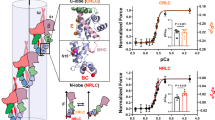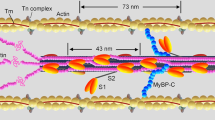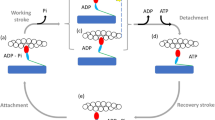Abstract
IN muscle each myosin head contains a regulatory light chain (LC2) that is wrapped around the head/rod junction, and an alkali light chain that is distal to LC2 (ref. 1). The role of these light chains in vertebrate skeletal muscle myosin has remained obscure2,3. Here we prepare heavy chains that are free of both light chains in order to determine by a motility assay4 whether the light chains are necessary for movement. We find that removal of light chains from myosin reduces the velocity of actin filaments from 8.8 µm s –1 to 0.8 µm s –1 without significantly decreasing the ATPase activity. Reconstitution of myosin with LC2 or alkali light chain increases filament velocity to intermediate rates, and readdition of both classes of light chains fully restores the original sliding velocity. We conclude that even though the light chains are not essential for enzymatic activity, light-chain/heavy-chain interactions play an important part in the conversion of chemical energy into movement.
This is a preview of subscription content, access via your institution
Access options
Subscribe to this journal
Receive 51 print issues and online access
$199.00 per year
only $3.90 per issue
Buy this article
- Purchase on Springer Link
- Instant access to full article PDF
Prices may be subject to local taxes which are calculated during checkout
Similar content being viewed by others
References
Katoh, T. & Lowey, S. J. Cell Biol. 109, 1549–1560 (1989).
Wagner, P. D. & Giniger, E. Nature 292, 560–562 (1981).
Sivaramakrishnan, M. & Burke, M. J. biol. Chem. 257, 1102–1105 (1982).
Toyoshima, Y. Y. et al. Nature 328, 536–539 (1987).
Wagner, P. D. & Weeds, A. G. J. molec. Biol. 109, 455–470 (1977).
Pastra-Landis, S. C. & Lowey, S. J. biol. Chem. 261, 14811–14816 (1986).
Trybus, K. M. & Chatman, T. A. J. biol. Chem. 268, 4412–4419 (1993).
Winkelmann, D. A., Lowey, S. & Press, J. L. Cell 34, 295–306 (1983).
Warshaw, D. M., Desrosiers, J. M., Work, S. S. & Trybus, K. M. J. Cell Biol. 111, 453–463 (1990).
Flicker, P. F., Wallimann, T. & Vibert, P. J. molec. Biol. 169, 723–741 (1983).
Moss, R. L., Giulian, G. G. & Greaser, M. L. J. biol. Chem. 257, 8588–8591 (1982).
Hofmann, P. A., Metzger, J. M., Greaser, M. L. & Moss, L. M. J. gen. Physiol. 95, 477–498 (1990).
Pollenz, R. S., Chen, T-L. L., Trivinos-Lagos, L. & Chisholm, R. L. Cell 69, 951–962 (1992).
Rayment, I. et al. Science 261, 50–58 (1993).
Kwon, H. et al. Proc. natn. Acad. Sci. U.S.A. 87, 4771–4775 (1990).
Vibert, P. & Cohen, C. J. Musc. Res. Cell Motil. 9, 296–305 (1988).
Huxley, H. E. & Kress, M. J. Musc. Res. Cell Motil. 6, 153–161 (1985).
Lowey, S., Waller, G. S. & Trybus, K. M. J. biol. Chem. (in the press).
Work, S. S. & Warshaw, D. M. Analyt. Biochem. 202, 275–285 (1992).
Author information
Authors and Affiliations
Rights and permissions
About this article
Cite this article
Lowey, S., Waller, G. & Trybus, K. Skeletal muscle myosin light chains are essential for physiological speeds of shortening. Nature 365, 454–456 (1993). https://doi.org/10.1038/365454a0
Received:
Accepted:
Issue Date:
DOI: https://doi.org/10.1038/365454a0
This article is cited by
-
Myosin light chain of shark fast skeletal muscle exhibits intrinsic urea-resistibility
Scientific Reports (2023)
-
Mechanisms of Sarcomere Protein Mutation-Induced Cardiomyopathies
Current Cardiology Reports (2023)
-
Alpha and beta myosin isoforms and human atrial and ventricular contraction
Cellular and Molecular Life Sciences (2021)
-
The role of super-relaxed myosin in skeletal and cardiac muscle
Biophysical Reviews (2015)
-
The path to visualization of walking myosin V by high-speed atomic force microscopy
Biophysical Reviews (2014)
Comments
By submitting a comment you agree to abide by our Terms and Community Guidelines. If you find something abusive or that does not comply with our terms or guidelines please flag it as inappropriate.



